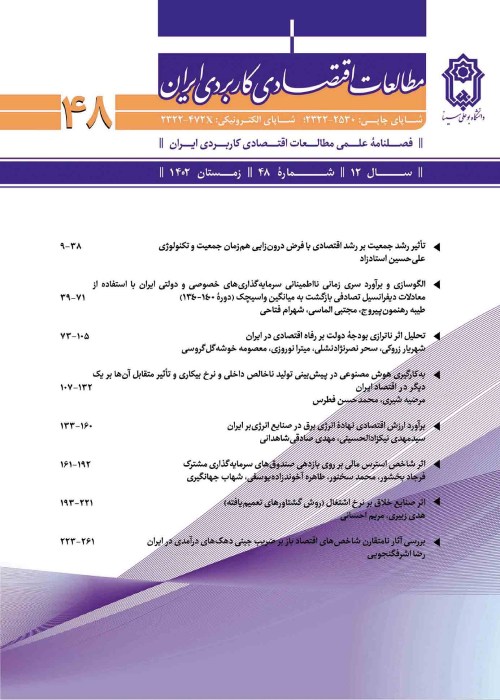The Calculation of the Inflationary Bias of Time Inconsistency of Monetary and Fiscal Policies in the Five-Years Development Plans of Iran
Author(s):
Abstract:
In recent years, the causes of double-digit inflation in the economy of Iran have been the biggest challenge for Iranian researchers. However, time inconsistency has been paid less attention while according to Kydland and Prescott (1977), time inconsistency of monetary policy can be the most important cause of inflation bias.
A policy is time inconsistent or dynamic inconsistent when it is considered as the best policy for particular time in the future, but it does not remain so, when that particular time actually arrives. There are two possible mechanisms that have been considered for such a time inconsistency. (i) Strotz(1955-1956) explain that time inconsistency is because of changing preferences, (ii) Kydland and Prescott(1977) consider another explanation that is based on agents rational expectation. The main idea is, when people expect low inflation, central bank thinks of high inflation. If people understand it, they predict higher inflation. In this situation, predicted inflation is optimal inflation. In other word, while inflation policy is optimal at first, high inflation policy will be optimal in the end. We use the second mechanism in this paper. Barro and Gordon (1983) have explained time inconsistency of monetary policy as follow: in a discretionary regime, central banker can print more money and make more inflation than peoples expectation. Benefits of this surprising inflation might provide more economic activities or reduce governments debt. However, if people, due to their rational expectation, understand it and adjust their expectations with it, then policy maker will not reach his target at all. Besides that, due to increased money supply, the level of prices will grow.
So the question that arises here is how much of the inflation is due to discretionary behaviors in applying monetary and fiscal policies? In other words, what is the inflationary bias caused by the Time Inconsistency of monetary and financial policies?
In the present study, the framework of Barro-Gordon has been applied to calculate the inflation bias of time inconsistency of monetary and fiscal policies. In fact, we have extended Walsh (2010)smodel by adding fiscal variable. These models consist of two main sections: loss function and the supply curve. According to the structure of the economy of the developing countries, the fiscal and monetary policies are dependent and are determined by a third person (the president). Thus, a general loss function which consists of fiscal and monetary variables is used. In fact, the lack of independence of the central bank is considered in this model.
What distinguishes this study from other studies, include: Calculating the inflation bias using a model that considers the time inconsistency of monetary and fiscal policies simultaneously.
Unlike Surico (2008), we used symmetric loss function.
Calculating inflation bias in Each Economic Development plan of Iran
The model solution will be done by two approaches of discretion and commitment. After applying the optimization, inflation bias will be the difference of results of these two approaches. Moreover, the inflationary bias of the model is calculated based on Irans economy data over the period of 1991-2016. This bias is then calculated for each of the country's five-year economic development plan.
The results show high inflation bias in Iran (9.8%). Furthermore, based on the results, the first and the third economic development plans have the lowest and the highest inflation bias, respectively. Besides that, it can be seen, predicted inflation in third and second part of fifth economic development plans, have significant difference with performance inflation. In other words, the present model has failed to provide an adequate estimate of the inflation of these two periods. It seems that the reason is considering high target inflation in two plans.
A policy is time inconsistent or dynamic inconsistent when it is considered as the best policy for particular time in the future, but it does not remain so, when that particular time actually arrives. There are two possible mechanisms that have been considered for such a time inconsistency. (i) Strotz(1955-1956) explain that time inconsistency is because of changing preferences, (ii) Kydland and Prescott(1977) consider another explanation that is based on agents rational expectation. The main idea is, when people expect low inflation, central bank thinks of high inflation. If people understand it, they predict higher inflation. In this situation, predicted inflation is optimal inflation. In other word, while inflation policy is optimal at first, high inflation policy will be optimal in the end. We use the second mechanism in this paper. Barro and Gordon (1983) have explained time inconsistency of monetary policy as follow: in a discretionary regime, central banker can print more money and make more inflation than peoples expectation. Benefits of this surprising inflation might provide more economic activities or reduce governments debt. However, if people, due to their rational expectation, understand it and adjust their expectations with it, then policy maker will not reach his target at all. Besides that, due to increased money supply, the level of prices will grow.
So the question that arises here is how much of the inflation is due to discretionary behaviors in applying monetary and fiscal policies? In other words, what is the inflationary bias caused by the Time Inconsistency of monetary and financial policies?
In the present study, the framework of Barro-Gordon has been applied to calculate the inflation bias of time inconsistency of monetary and fiscal policies. In fact, we have extended Walsh (2010)smodel by adding fiscal variable. These models consist of two main sections: loss function and the supply curve. According to the structure of the economy of the developing countries, the fiscal and monetary policies are dependent and are determined by a third person (the president). Thus, a general loss function which consists of fiscal and monetary variables is used. In fact, the lack of independence of the central bank is considered in this model.
What distinguishes this study from other studies, include: Calculating the inflation bias using a model that considers the time inconsistency of monetary and fiscal policies simultaneously.
Unlike Surico (2008), we used symmetric loss function.
Calculating inflation bias in Each Economic Development plan of Iran
The model solution will be done by two approaches of discretion and commitment. After applying the optimization, inflation bias will be the difference of results of these two approaches. Moreover, the inflationary bias of the model is calculated based on Irans economy data over the period of 1991-2016. This bias is then calculated for each of the country's five-year economic development plan.
The results show high inflation bias in Iran (9.8%). Furthermore, based on the results, the first and the third economic development plans have the lowest and the highest inflation bias, respectively. Besides that, it can be seen, predicted inflation in third and second part of fifth economic development plans, have significant difference with performance inflation. In other words, the present model has failed to provide an adequate estimate of the inflation of these two periods. It seems that the reason is considering high target inflation in two plans.
Keywords:
Language:
Persian
Published:
Quarterly Journal of Applied Economics Studiesin Iran, Volume:6 Issue: 23, 2017
Pages:
61 to 84
magiran.com/p1756173
دانلود و مطالعه متن این مقاله با یکی از روشهای زیر امکان پذیر است:
اشتراک شخصی
با عضویت و پرداخت آنلاین حق اشتراک یکساله به مبلغ 1,390,000ريال میتوانید 70 عنوان مطلب دانلود کنید!
اشتراک سازمانی
به کتابخانه دانشگاه یا محل کار خود پیشنهاد کنید تا اشتراک سازمانی این پایگاه را برای دسترسی نامحدود همه کاربران به متن مطالب تهیه نمایند!
توجه!
- حق عضویت دریافتی صرف حمایت از نشریات عضو و نگهداری، تکمیل و توسعه مگیران میشود.
- پرداخت حق اشتراک و دانلود مقالات اجازه بازنشر آن در سایر رسانههای چاپی و دیجیتال را به کاربر نمیدهد.
In order to view content subscription is required
Personal subscription
Subscribe magiran.com for 70 € euros via PayPal and download 70 articles during a year.
Organization subscription
Please contact us to subscribe your university or library for unlimited access!



